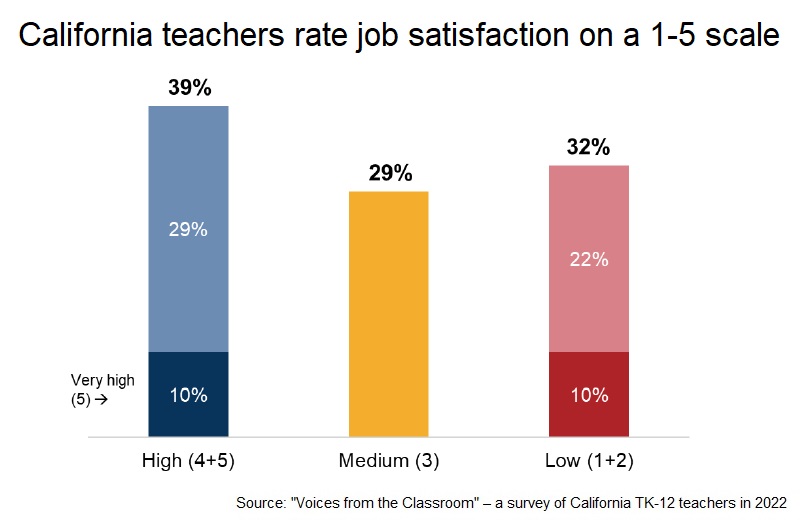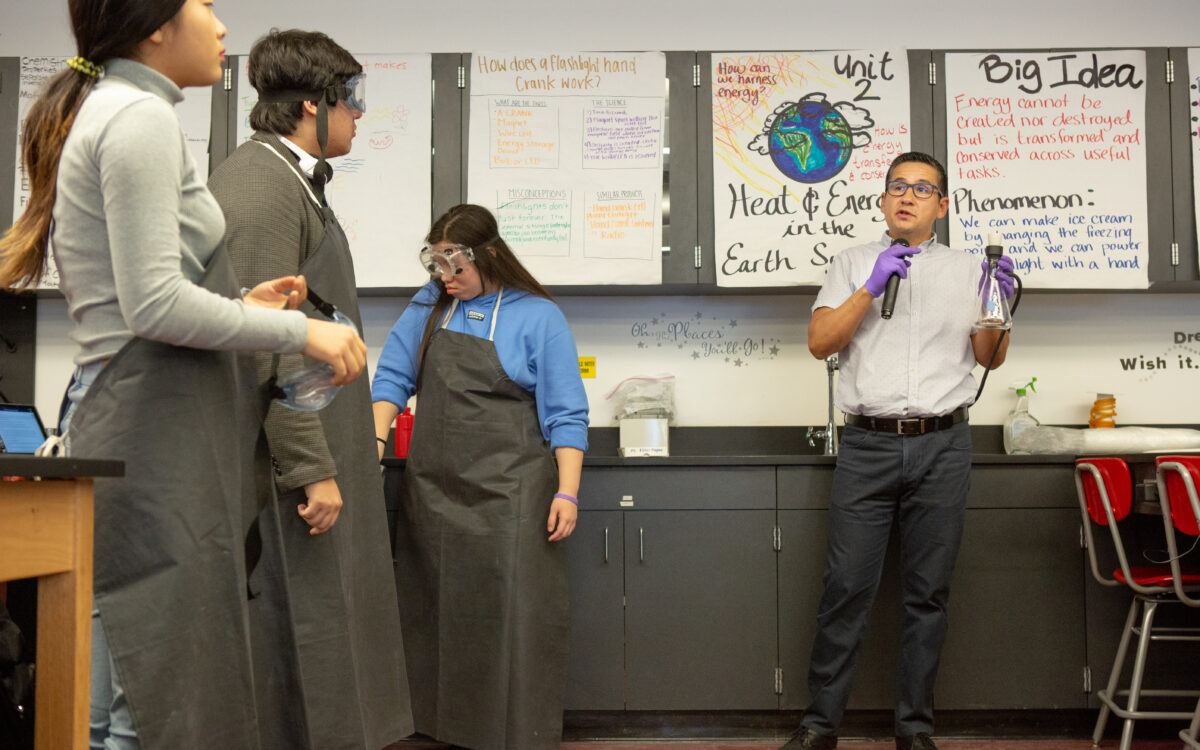A large-scale survey this past summer of California teachers confirms what has emerged as a byproduct of two-plus years of a pandemic: Large numbers of teachers characterize their work as “stressful” and “exhausting.” And nearly twice as many teachers than in the past say that job conditions have changed for the worse.
The results of the survey of 4,632 teachers, commissioned by the California Teachers Association and UCLA Center for the Transformation of Schools, was released on Tuesday. Hart Research Associates administered the survey; all the teachers are CTA members.
The survey points to multiple reasons for unhappiness, and those teachers who are considering leaving the profession cited burnout from stress (57%) and political attacks on teachers (40%), followed by a heavy workload compounded by staff shortages. A low salary, a lack of respect from parents and a lack of a work-life balance also were high on the list.

The survey found that 1 in 5 teachers say they will likely leave the profession in the next three years, including 1 in 7 who say they will definitely leave. An additional 22% say there is a 50-50 chance they will leave.
However, national data of recent teacher resignations call into question what the survey called California’s “crisis of retention.” Research and a review of surveys by Education Week concluded that the rate of teacher attrition did rise in 2021-22, but only by a few percentage points, to 7% nationally and to 10% in large urban and low-income districts.
Dan Goldhaber, vice president at the American Institutes of Research, whose study of teacher turnover in Washington state also found a slight uptick in attrition in 2021-22, said “data definitely do not support the idea that anywhere near the number of teachers who suggest they may leave actually leave.” But he added, in his Washington state analysis, “That does not mean we should be unconcerned; we should take reports of teacher burnout and dissatisfaction seriously, even if they do not lead to attrition.”

The California survey paints a nuanced portrait: While many teachers think about exiting teaching, most said they continue to like it; more than two-thirds said that they are very satisfied (39%) or moderately satisfied (29%) with their positions. That leaves 32% with low satisfaction. Older and high school teachers were more likely than younger and elementary school teachers to say they are highly satisfied. Slightly more Black and Asian American teachers indicated they will likely leave the profession than white and Latino teachers.
“There are teachers who feel satisfied with their jobs and pay structure, but it’s incumbent upon us to address why 30% say they’re not,” said Kai Monet Mathews, research director of UCLA Center for the Transformation of Schools.
“The changes brought about by the pandemic will have a lasting impact. Teachers are more overwhelmed than before. We should be proactive — hear the voices of teachers and listen to their concerns.”
Teachers said the primary motivation for entering and staying in the profession is to help students and make a positive difference in their lives. Schedules with summers off, job security and good pension and health benefits were secondary reasons.
But teaching has proven to have positives and negatives. Asked what they like most about their current position, current teachers cited connecting with their students (42%) and helping their students grow and develop (43%).
Yet when asked what they like least about their position, teachers pointed to student apathy, discipline and behavioral problems (32%). In two-dozen in-depth interviews, teachers said inadequate training in classroom management and a lack of support from administrators and parents compounded the behavior problems. Teachers who said they planned to leave the profession cited strengthening discipline for disruptive behaviors and raising pay as two top ways to retain teachers.
The National Education Association projected that the average teacher in California would earn $87,275 in 2020-21, the third-highest salary among teachers in the nation. Three-quarters of the teachers surveyed reported annual household incomes of more than $100,000, with 36% more than $150,000. But California is also one of the least affordable states, exacerbated by escalating housing costs in the Bay Area and Southern California.
Most of the teachers surveyed said they are experiencing financial stress: 80% said it is difficult to find affordable housing near where they teach; 75% said it was difficult to save for long-term goals, to keep up with basic expenses (68%), to save for retirement (68%), and to live comfortably and maintain the lifestyle they want (64%).
Asked for four changes to improve retention, teachers cited better pay as the top priority, followed by smaller class sizes, a more manageable workload and more support services for students.
Two dozen aspiring teachers also cited the financial burden of tuition and qualifying tests. They expressed positive views of teacher residencies, internships and clinical practice but not the cost.
“I was and am willing to do whatever it takes to be a teacher. However, the cost of tuition, compared to how much teachers make, is very sad. The cost of student-teaching was 10 grand and has been a huge challenge for me,” said one interviewee, a 23-year-old woman.
Fulfilling 600 hours of practice in a classroom to become a full-time teacher in California requires taking a semester off, Mathews said. Access to becoming a teacher is limited if you don’t have a partner or a family to support you during that time. Most affected are low-income, aspiring teachers of color, she said.
“It’s time to have a broad, creative conversation about compensation with the community,” Mathews said, and consider benefits that aren’t necessarily in the form of a monthly paycheck, like providing housing stipends, covering student loans, universal paid teacher residencies — “a GI bill for teachers,” Mathews said. “Teachers need to be seen as part of the social fabric, compensated and taken care of.”
Challenge of achieving full inclusion
The success of retaining and recruiting teachers in an increasingly diverse state will depend on creating school environments that support diversity. The survey indicates teachers see a need for significant improvement, although how much depends on subtle differences in perception.
More than 80% of teachers said they feel comfortable being their “authentic” selves at their schools and that their schools support different cultures; 77% said they felt a sense of belonging in school. But they were divided over whether they “strongly” or “somewhat” hold these views. Nearly two-thirds of teachers said their school leadership demonstrates a genuine commitment to cultivate diversity. But only 32% said they strongly believe that their leaders are fully committed.
The report says there are significant differences between whether white teachers and teachers of color strongly feel a sense of belonging at their school. But the data shows identical proportions — 41% — of white and Latino teachers feel that way. The data also shows, however, that Black and Asian teachers feel much less comfortable being themselves in school. A key difference, former teachers of color said, was working at a school where some or all of the population was from a similar background as their own.
Only 38% of Black teachers reported never experiencing discrimination in their current positions; 31% reported experiencing it a few times; 19% said occasionally, and 12% —1 in 8 Black teachers — said it happened very often.
